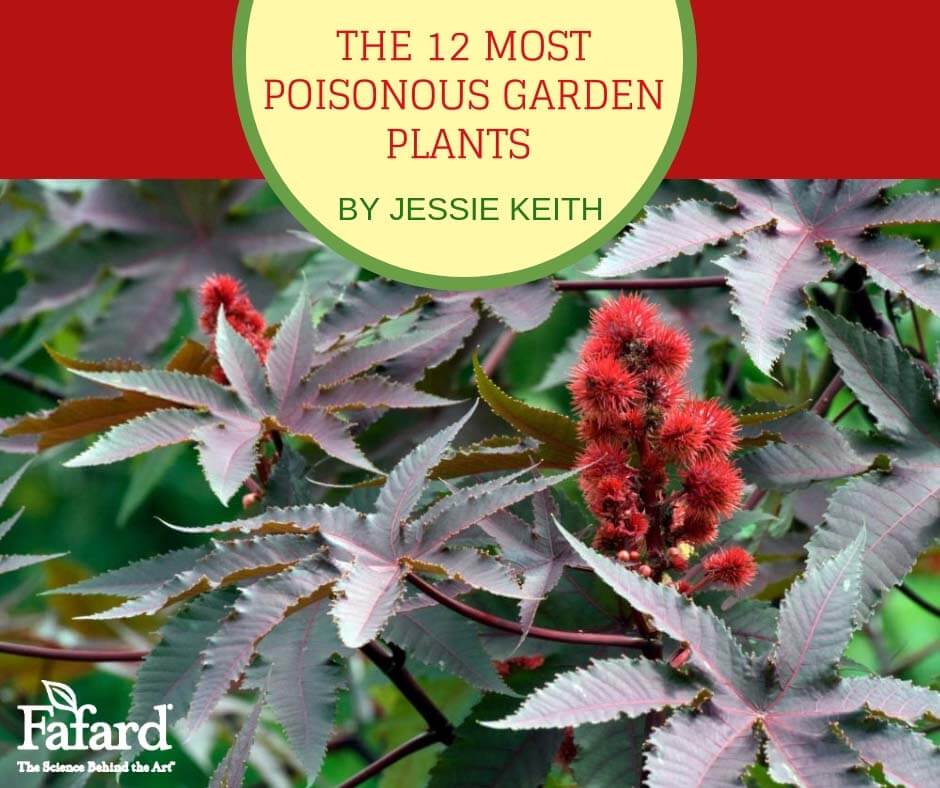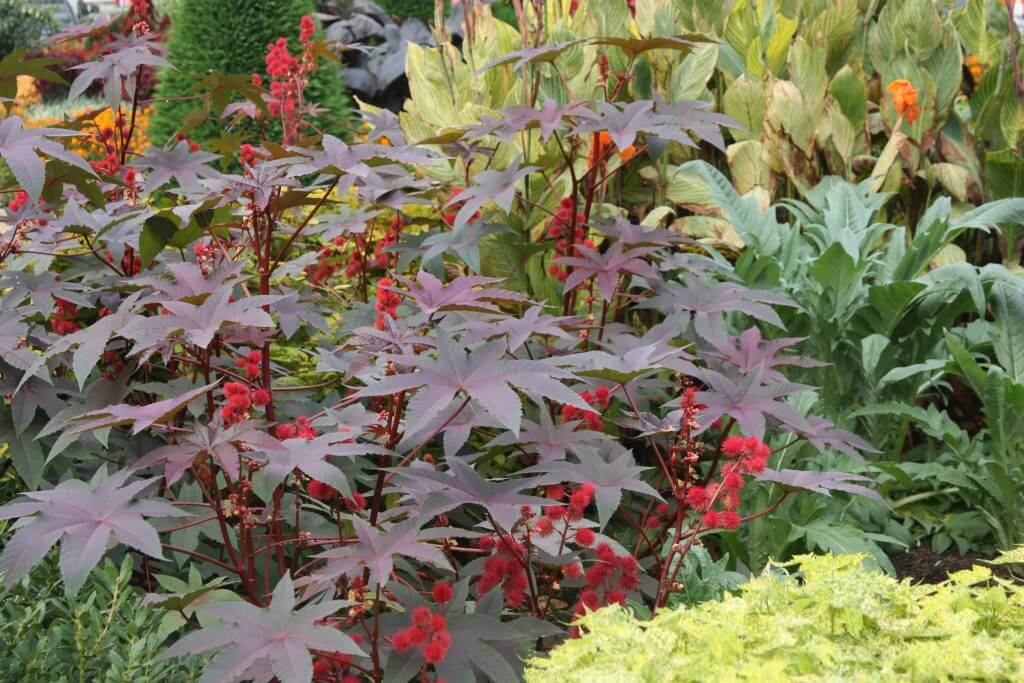
When I was seven, I found a beautiful plant covered with pretty purple flowers. I picked a bouquet for my mother, and when I gave it to her, she screamed. They were poisonous nightshade blooms! She rushed me to the bathroom to wash my hands and repeatedly asked whether I’d put my hands in my mouth. It was so frightening, but my mother’s basic knowledge of toxic plants kept me safe.
Once I had children, I armed myself with the same knowledge and quickly learned that my garden was full of poisonous plants. Lots of garden favorites pose a true threat to humans, pets, and livestock. The worst contain neurotoxins, able to kill if ingested or even handled. Some have even caused intrigue of historical significance.
Castor beans (Ricinus communis) contain ricin, a poison famously used in the 1978 assassination of Bulgarian dissident novelist Georgi Markov by Bulgarian secret police using a ricin-injected umbrella. Wolf’s bane (Aconitum spp.) contains aconitine, a common deadly poison of the ancient world that appears repeatedly in Greek and eastern mythology and custom. In fact, and Greeks used aconitum-juice-tipped arrows to kill wolves, hence the common name, while the Japanese used tipped arrows to hunt bear. The deadly Indian rosary pea (Abrus precatorius) has pretty scarlet and black seeds grown for jewelry beads, but they are so lethal, jewelry makers have died handling them with pricked fingers.
Knowledge is power, which is why I created this list of poisonous garden flowers, shrubs, vines, and trees. If you have pets and/or children, protect them from the plants on this list!
Monkshood (Aconitum spp.)

Beautiful hooded purple flowers make this a popular garden perennial, but beware the toxic underside of monkshood. Its deadly poison, aconitine, can enter the body from the skin as well as the mouth, so take caution when cutting it back. Never grow monkshood if you have children or pets. The grape purple flowers are too attractive. Gardeners should also be warned before growing it.
Horse Chestnut (Aesculus hippocastanum)

Robust horse chestnut trees have beautiful white flower clusters in spring that develop into hulled, smooth brown seeds that look like edible chestnuts. Children love the pretty seeds, which were used by UK children to play a game called conkers, but horse chestnuts are toxic if ingested. They contain aesculin, a poison known to cause unconsciousness, paralysis, and even death in humans, livestock, and pets. If you have a horse chestnut, teach older children about their dangers, and keep the nuts away from young children and pets.
Morning Glory (Ipomoea spp.)

Vining morning glories have beautiful flowers that attract bees, hummingbirds, and moths, but their profuse seeds are poisonous. They contain toxic alkaloids that cause disorientation, nausea, and diarrhea if consumed. The papery seed capsules rattle and release the angled black seeds when crushed, so they attract kids, and occasionally pets. Morning glory seed packets are also a danger, so keep them out of reach of children if you choose to grow these annual vines.
Angel’s Trumpet (Brugmansia and Datura spp.)

Never grow angel’s trumpets if you have children or pets. Their impressive, trumpet-shaped flowers have garden appeal, but they are fatally poisonous—with many human deaths attributed to them. The plants and seeds contain toxic alkaloids that can kill if ingested. Wear gloves at pruning time, to avoid their toxic sap, and never put pruned stems on the burn pile as their smoke is poisonous to inhale.
Gardeners should also look out for the common field weed called jimsonweed (Datura stramonium). It is just as toxic as cultivated forms and can appear in the garden unannounced.
Lily-of-the-valley (Convallaria majalis)

Who hasn’t picked delicate stems of fragrant, nodding lily-of-the-valley? They are some of the sweetest garden flowers around, but if ingested, the blooms, orange-red fruits, and leaves can cause blurred vision, slowed heartbeat, collapse, and even death. The toxins convallatoxin and convalloside are to blame. This rampant groundcover should be removed with pets or small children around. Older children and adults should also be warned about its dangers.
Foxgloves (Digitalis purpurea)

Foxgloves are beautiful, old-fashioned garden flowers, but their dangerous toxins can stop the heart. Foxgloves have been reported to kill livestock, pets, and humans. Children have even been poisoned by drinking the vase water from flower arrangements containing foxgloves. The tall spikes of colorful, tubular blooms are very attractive, so don’t grow them with young ones around. Only well-advised adults should handle the plants or pick their flowers.

English Ivy (Hedera helix)

This is one of the most common evergreen groundcovers for landscapes and gardens, but the leaves and fruit are toxic. Vines must grow to very large heights to fruit, so in most cases, it is the leaves to avoid. Touching the leaves can cause severe dermatitis in some people, and ingestion of the leaves and berries can cause severe sickness and even coma. So, when pruning back or removing these vines, wear thick gloves and wash your pruners afterwards.
Warn children about the dangers of this vine, and try to make sure pets don’t eat the leaves. Indoor specimens are especially attractive to cats that play with and eat the house plants. Dogs may also be attracted to them.
Lantana (Lantana camara)

The bright tropical colors of lantana flowers brighten many a flower border and container, but sadly all plant parts are toxic, especially the berries. There are many reported cases of human and animal poisonings, so take care when planting these in your garden.
Black Cherry (Prunus serotina)

The pits, foliage, and branches of black cherry contain the deadly poison, cyanide. Foraging livestock is sometimes killed by eating the leaves of this common Native American tree.
The clusters fragrant, white spring flowers mature to profuse clusters of small, black cherry fruits that are attractive to children. The fruits are the only plant parts that are not poisonous (aside from the tiny pits), but for the sake of safety, don’t try eating them. If you have a black cherry that you don’t want to cut down, be sure to keep children and pets far from it at fruiting time.
Oleander (Nerium oleander)

Commonly planted in Southern gardens, oleander is one of the most poisonous plants you can grow due to the poison, oleandrin. This toxin damages the heart and will cause heart arrhythmia and can even cause death.
Avoid touching the sap when pruning its branches, and refrain from burning cut stems as the smoke will also emit toxins. The colorful flowers and their nectar are also poisonous.
Castor Bean (Ricinis communis)

Bold castor bean is a popular annual garden plant, but both the plants and their seeds contain the deadly toxin, ricin. The bean-like seeds are so toxic, it is a serious liability to grow castor bean. Children are especially at risk. There are other bolder, prettier garden flowers that can be grown in its place, such as red maple leaf hibiscus (Hibiscus acetosella).
Yew (Taxus spp.)

This popular landscape evergreen bears juicy, red berries with green centers that look appetizing to kids, but the green centers are poisonous along with all other plant parts. There are reports of animals dying from eating the foliage, so be cautious if you have yews. Keep your children from the berries and pets from the foliage.
For more information about poisonous plants visit these websites:
ASPCA Toxic Plants List for Pets
Canadian Poisonous Plants Information System
Texas A&M Poisonous Plants List
The US government’s toll-free Poison Help line, 1-800-222-1222, connects you to your local poison center, in case of plant ingestion.
Read the Fafard disclaimer here.

